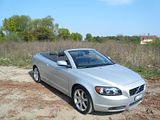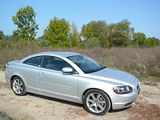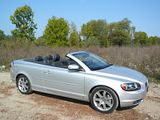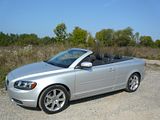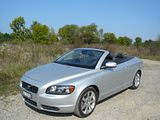Back in 2003, I owned a Volvo C70 for about 5 months. That car was the coupe based on the old 850/S70 design, and was a big comfortable cruiser, but even though it was fitted with the much praised and potent T5 engine, it never really managed to excite me. Unusually for this day and age, in 2006, Volvo used the same name for a replacement that was noticeably smaller, and somewhat cheaper, based on the S40/V50 cars, themselves sharing much of their underlying platform with the Focus, albeit with Scandinavian design and some engineering, such as the higher-end engines, that was unique to the Volvo.
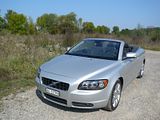
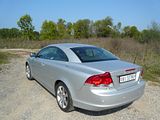
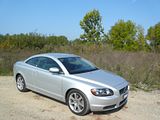
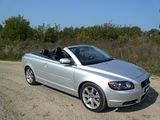
The last time I drove a Volvo C70 was on one of Volvo’s “Test Drive” days, where you could sign up for 3 cars and a 30 minute drive in each. I remember going out in and entry level diesel S40 and a top spec V50 and when I returned to collect the third car, a C70, there was a bit of a problem as someone had just mechanically destroyed one of the two cars at the event (something to do with an driver inexperienced with the use of a clutch pedal!). After something of a wait, I did get to go out in one, but it was a rather hurried trip round the same circuit as I had completed earlier in the day. Overall impressions of all three cars were largely good, though I recall baulking at the price tags of the models toward the top end of the range. Since then, I have renewed my acquaintance with the 1.6D engine in both a V50 and a C30, and with this latest test have now had the chance to move up the range and sample the 2.4 litre normally aspirated engine in the C70 convertible.
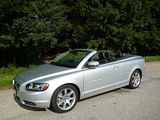
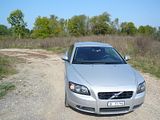
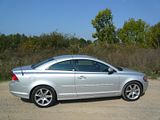
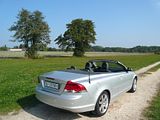
This is the less powerful of the two petrol motors offered in the car, and it develops 170 PS from its normally aspirated 5 cylinder engine. Enough, Volvo claim, to allow it to accelerate from 0 – 60 in 9.1 seconds. In absolute terms, that is not particularly fast, but it is brisk enough. Indeed, that was my over-riding impression of this car after enjoying a day driving around with the roof down enjoying the late September sunshine. This is not a car that you select for its outright speed, but one that you could well enjoy as a long distance cruiser. In this mode, the C70 is in its element. The 5 cylinder motor is very smooth and refined and has that distinctive noise that only a engine of this configuration can generate. Never intrusive, on accelerating, your ears tell you that this is not the sound you are used to from either a 4 or a 6. Although outright power may only be moderate, the torque characteristics of the engine were such that once sufficient revs were achieved, it could thrust forward very pleasingly. At lower revs, the only solution was to accelerate hard towards the next gear, at which point you got the chance to use the very slick-shifting 5 speed gearbox. The short stubby lever slides easily from gear to gear and also goes readily into reverse – not something which you find universally even now in all cars. The test car was spared the arduous alpine climbs as the weather forecast suggested I would see more sun and fewer clouds by heading west and north, so I ended up driving on a mix of autobahn and “routes nationales” around Basel and that part of France where all the towns and villages have German sounding names, in Alsace. Overall consumption worked out at just over 35 mpg, which I thought was not bad, especially as the roof was down all day, and this would not have helped fuel economy.
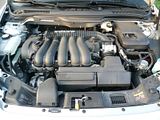

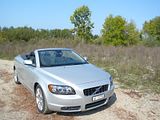
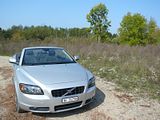
Although the C70 is based on the same platform as the Focus, it does not quite share the same excellence of steering and handling qualities that so benefits the Ford product. The steering is just slightly less than crisp-feeling and the handling, although predictable has that touch of understeer and roll that makes for a less sharp driving experience than Ford offers. The upside of this is that C70 rides well. A combination of this and the supremely comfortable seats reinforce my contention that this is a relaxed cruiser. The brakes are good, and there is still a conventional centre console mounted traditional handbrake on this car.
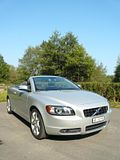

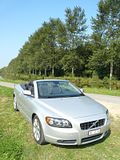
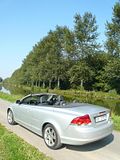
Inside the cabin and the dashboard is immediately familiar to anyone who has driven an S40, V50 or C30, as to all intents and purposes, it is the same. The main instrument binnacle contains just two dials: rev counter and speedo with the smaller gauges for fuel level and water temperature set in the larger dials. In between, there is space for numerous warning lights and a small textual info display which can cycle through average speed, fuel consumption and the like, if you rotate a dial in the end of the indicator stalk. The dials are crisply marked and easy to read. The lights switch, to the left of the column is very small and fiddly, and has a warning light to its side to indicate that the lights are illuminated. The centre console is of the “floating” design, meaning that there is a small cubby hole behind it, which is perfect for storing a camera, but a little awkward to access. The console itself has the controls for the stereo and climate control/air conditioning, and is remarkable for its unfussiness, with clearly labelled dials and buttons, relatively few in number. Indeed that is the overriding impression from the cabin as whole: stereotypically clean and clear Swedish design.
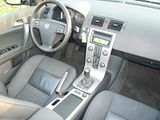


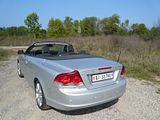
There is ample space in the car for four passengers, with plenty of legroom for those in the back. Oddment space is provided by a couple of roll-top covers in the centre console, the area behind the gearlever and centre console, a decent glove box and some lidded bins on the door, which have a central partition preventing anything every sizeable from being put in there. There is a ski hatch from the boot to the rear seats for those long loads, usable only when the roof is up.
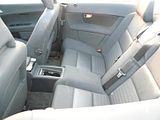

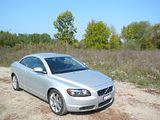
With the roof up, there is a generously sized boot. With the roof lowered, and the protecting shelf in situ, there is remarkably little space. I managed to get the bag for my PC and the soft squashy sports bag with the week’s clothes in it under the roof shelf, and there was some space for other shallow items. Of course, you cannot retrieve anything when the roof is down, as there is next to no clearance between the back of the car and the roof shelf. In this respect, the C70 is no worse than many of its competitors, of course.
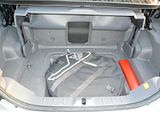
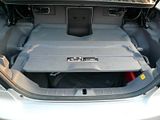
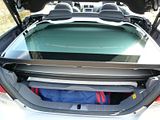
Putting the roof up and down is simplicity itself. The cover in the boot does have to be in situ, then you turn on the ignition, put your foot on the footbrake, and press the “open” switch that is behind the gearlever. The whole performance takes about 30 seconds, as the boot lid opens, the roof lifts from the header rail then separates into three parts and folds neatly into the boot. Closing the roof is the same procedure in reverse. There is a separate switch to close it, alongside the one to open it. No clips to undo, and when you close the roof, it even closes all the windows for you.
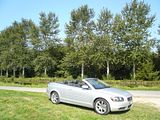
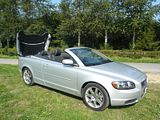

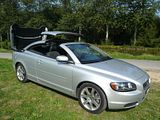

Needless to say, I drove around the whole day with the roof down, raising it only when parking up or taking some pictures. Even with the improved visibility of no roof, I was grateful for the rear parking sensors, as judging the back of the car is difficult, and I had to slot it into a tight spot in one town during the day. There was no buffeting with the roof down, but there was some annoying wind noise from around the driver’s mirror. Unlike some convertibles, this one is not bad to drive and see out of with the roof up. There are generous rear side windows and the back window is large, so the car is airy inside and visibility is not bad. However, when the weather allows, you’d want to drive with the roof down – or why buy a convertible?
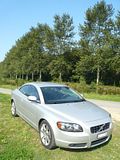
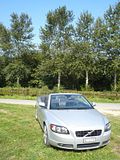
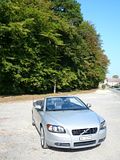
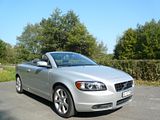
Volvo offer long and complex lists of options these days. The test car came with a fairly basic spec, but this did include parking sensors, climate control with heated front seats, a good quality stereo system (something Volvo does particularly well), as well as number of safety features, including numerous airbags and the ROPS (Roll Over Protection System) which would protect the occupants of the rear seats should the car turn over. Unwanted fripperies, such as fake metal trim on the dash and a surfeit of buttons all over the cabin were pleasingly conspicuous by their absence. As well as being able to upgrade to a couple of different diesel engines, the C70 can be supplied with the T5 version of the 2.4 litre engine for an additional £1600. This motor will give more performance, for apparently little penalty in fuel consumption, and might be worth consideration. Everything else on the options list would be down to personal taste and budget.
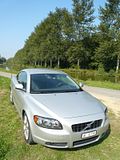
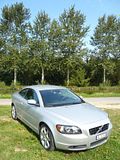
There was much to like about the C70. To my mind, it is one of the better looking of such cars, with both the roof down and up. The 5 cylinder engine has a pleasant, and slightly unusual thrum to it, and its combination of power and torque means that the C70 is a relaxed cruiser. The car is nicely finished inside, and feels like a quality car. As I was writing this, I was somewhat amused to see an advert for the C70 in which Volvo suggest that you should “meet your heart”. Advertising hyperbole, perhaps? More accurately – though I suspect they intended me to interpret this in a very different way – the advert goes on to say “at a price that sends shivers down your spine”. At a starting price of £27.625.00 for the entry level car like the one I tested, I’m afraid that is exactly what it does. That is several thousand pounds more than the Eos (its most obvious rival) and the other hatchback derived rivals such as the Focus CC, 308 CC, Astra and Megane. It is cheaper than the A5 and 3 Series, but not by all that much, and it is both smaller internally and less powerful than them. That either leaves it looking awkwardly positioned in the marketplace or as a unique proposition bridging the 2 classes of coupe/cabrio. Regardless of how you see it, I found it a pleasant car. I would not choose to own one, but I’d happily take one out for a relaxed cruise to enjoy with the roof down.
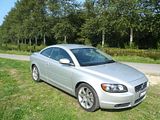
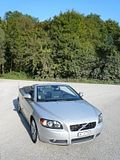
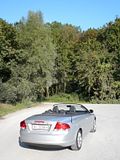
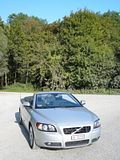
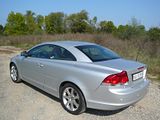
2009-09-28 18:16:48












































